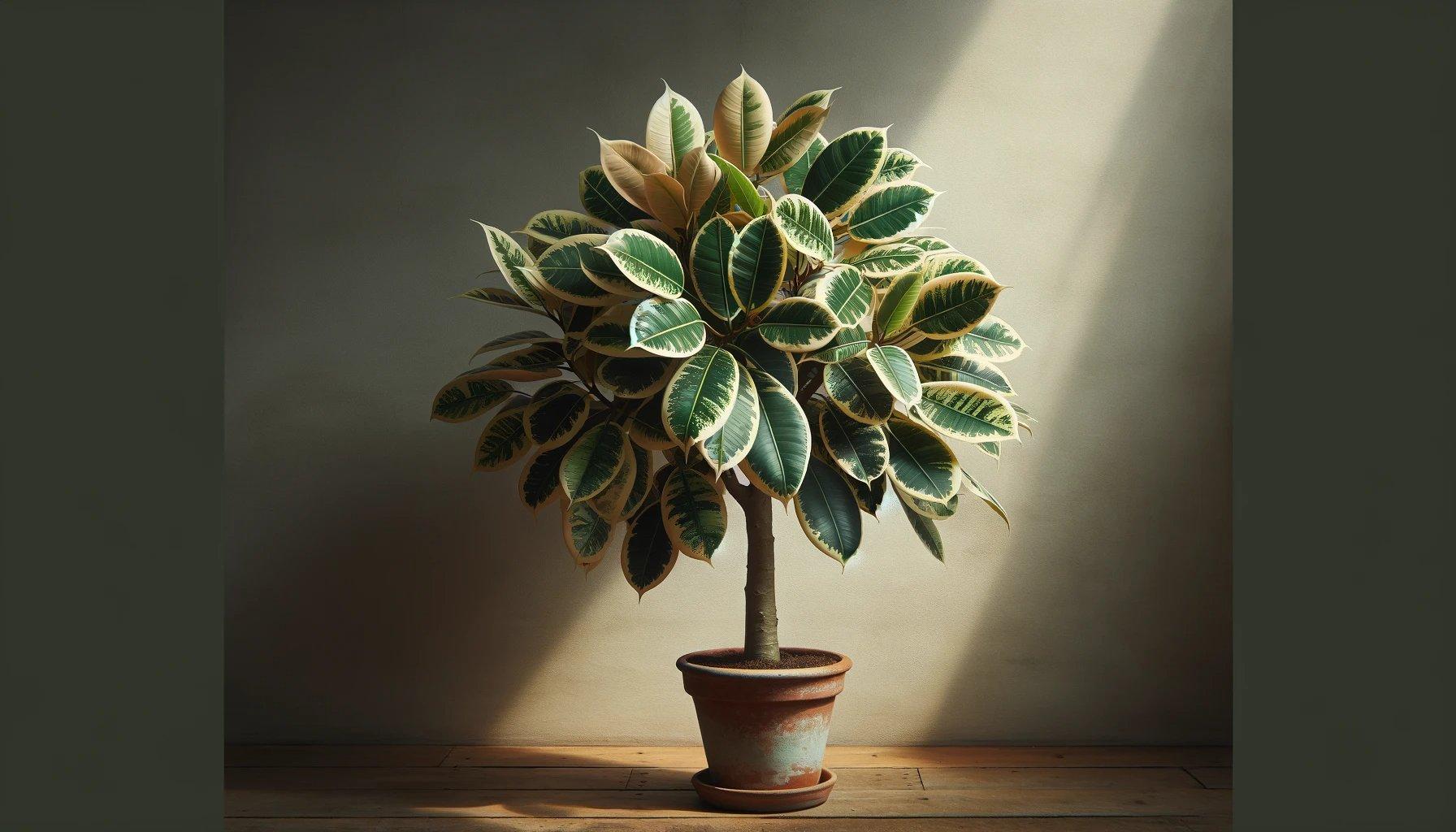Hello, fellow plant enthusiasts! 🌱 Today, I’m thrilled to share my journey and expertise in caring for the striking Tineke Rubber Tree, a plant that has not only beautified my space but also brought me immense joy. Whether you’re a seasoned green thumb or a budding plant parent, this guide will help you navigate the essentials of nurturing this eye-catching beauty.

🌞 Lighting the Way: Ideal Light Conditions for Tineke Rubber Trees
The Tineke Rubber Tree, with its variegated leaves of green, white, and sometimes pink, loves bright, indirect light. It’s like a morning yoga session for them – energizing yet soothing. Place it near a window where it can bask in the morning light, but shield it from harsh afternoon rays to prevent leaf burn. This balance is key to keeping those beautiful leaves vibrant.
💧 Water Wisdom: Quenching Your Tree’s Thirst
Watering your Tineke Rubber Tree can be a delicate dance. They prefer a drink when the top inch of soil feels dry. Overwatering? A big no-no! It can lead to root rot. I usually check my plant every week, but remember, they need less water in the winter. Think of it like a bear hibernating – it’s all about conserving energy.
🏡 Creating the Right Environment
Your Tineke Rubber Tree craves a cozy environment – think warm and moderately humid. They’re not fans of the cold, so keep them away from drafty windows and doors. The ideal temperature range is between 60°F and 75°F. To boost humidity, especially in drier climates, a humidifier or a pebble tray with water can work wonders.
🌿 Growth Expectations: Watching Your Tree Flourish
One of the joys of having a Tineke Rubber Tree is watching it grow. With proper care, it can reach impressive heights, making it a stunning focal point in any room. Its growth can be a bit slower compared to other houseplants, but that gradual transformation is part of its charm.
🪴 The Art of Repotting: Keeping Your Tree Comfy
Repotting is like moving your tree into a bigger home as it grows. Every 2-3 years should be sufficient, or when you notice it becoming root-bound. Spring is the best time for this. Choose a pot that’s just a size bigger with good drainage, and use a well-draining soil mix. Your tree will thank you with more lush, vibrant leaves.
✂️ Propagating: Sharing the Beauty
Propagation is a fantastic way to create new plants from your Tineke Rubber Tree. You can use stem cuttings and root them in water or soil. It’s a rewarding process, watching a small cutting develop roots and become a new plant. Plus, they make great gifts for friends and family!
🚫 Pet Safety: A Cautionary Note
A crucial point to note: Tineke Rubber Trees are toxic to cats and dogs if ingested. If you have curious pets, it’s best to place your tree in a spot they can’t reach. Safety first!
Embracing the journey of caring for a Tineke Rubber Tree has been a delightful experience for me. It’s not just about the aesthetics; it’s about the connection and tranquility these plants bring into our lives.
| Pros (+) | Cons (-) |
|---|---|
| ✅ Visually Stunning<br>Their variegated leaves of green, white, and pink add a vibrant touch to any space. | ❌ Sensitive to Light<br>Too much direct sunlight can lead to leaf burn. |
| ✅ Air Purifying<br>Tineke Rubber Trees are known for improving indoor air quality. 🌬️ | ❌ Toxic to Pets<br>These plants are toxic if ingested by cats or dogs. 🐾 |
| ✅ Moderate Water Needs<br>They don’t require frequent watering, making them relatively low-maintenance. 💧 | ❌ Slow Growing<br>Patience is needed as they grow slower than some other houseplants. |
| ✅ Easy to Propagate<br>Propagation through stem cuttings is straightforward and rewarding. 🌿 | ❌ Requires Specific Environment<br>Needs a warm and moderately humid environment, which might require extra effort in some climates. 🌡️ |
| ✅ Boosts Well-Being<br>Having a Tineke Rubber Tree in your space can enhance mood and create a calming atmosphere. 🧘 | ❌ Prone to Pests<br>Can attract pests like spider mites if not cared for properly. |
Whether you’re a seasoned plant parent or just starting, remember that every plant has its unique personality and needs. Observing, learning, and adapting to these needs is the heart of plant care. Happy planting, and may your Tineke Rubber Tree thrive and bring you as much happiness as mine has brought me! 🌿💚
For a deep dive into the fascinating world of Tineke Rubber Trees, including their origin and varieties, don’t forget to check out this detailed Wikipedia article.
Megan Stewart, a houseplant aficionado and biologist, resides in the city of Portland, Oregon, USA. Her passion for greenery is matched only by her academic prowess; Megan holds a degree in Biology from the University of Oregon. This background has provided her with a rich understanding of the biological intricacies of plant life, which she skillfully applies to her collection of indoor plants.
Megan's home is a testament to her love for all things green, filled with a diverse array of houseplants ranging from exotic orchids to robust succulents. When she's not tending to her indoor garden, she spends her time with her beloved pets, a constant source of companionship and joy. Her articles are a reflection of her life's passions, offering readers a blend of practical plant care advice, and insightful biological tidbits.
Through her writing, Megan aims to inspire others in the USA and beyond to create their urban jungles and foster a deeper connection with nature.


